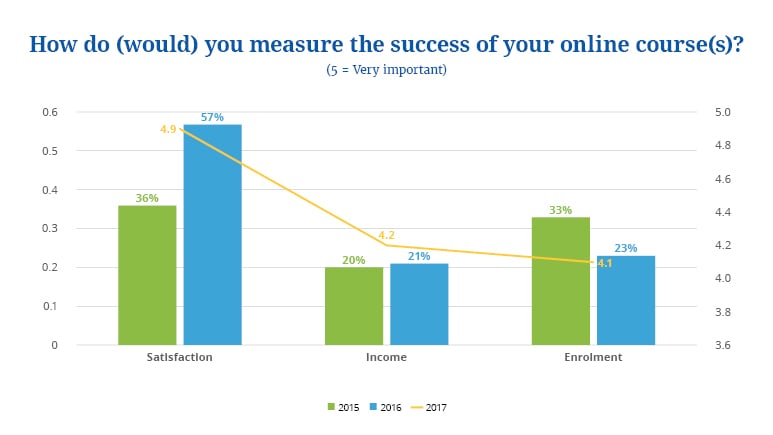Online learning has become the go-to mode of learning across academia, the corporate sector, and even for individual learners.
Reduced learning costs, greater convenience, and improved learning outcomes are the key factors driving the growth of online learning. On top of that, the COVID-19 pandemic has accelerated this trend even further.
Due to rapidly changing industry trends, it becomes difficult to form a comprehensive view of the current state of the online learning industry.
This is why we’ve created a complete list of up-to-date online learning statistics to capture the current state of affairs and trends in the industry.
- Online Learning Statistics (Highlights)
- eLearning Market Size and Growth
- The Impact of COVID-19 on the eLearning Industry
- Online Learning in the Academic Sector
- Corporate eLearning Statistics
- Massive Open Online Courses (MOOC) Statistics
- Course Creator Statistics
- State of the Emerging Trends in Online Learning
- Frequently Asked Questions
Online Learning Statistics (Highlights)
- The eLearning market size is projected to grow from $315 billion in 2021 to more than $1 trillion in 2028.
- 1.38 billion learners (around 80% of the global student population) were impacted by school closures during COVID-19.
- In 2020, 75% of all undergraduate students in the United States were enrolled in at least one online course.
- The corporate eLearning market was valued at $100 billion in 2021, and it’s projected to cross $450 billion by 2028.
- There are over 220 million registered massive open online course (MOOC) learners across the globe.
- Online classes result in nearly 87% less energy consumption and 85% less CO2 emissions when compared to traditional classroom courses.
eLearning Market Size and Growth
Let’s kick things off with the most important statistics on online learning that will give you an overview of the industry size and growth trends. We pulled these stats from market research studies, industry surveys, and other reports.
- The global eLearning market surpassed $315 billion in size in 2021.
- The market is expected to grow further at a CAGR of 20% and cross $1 trillion by 2028.

- According to a pre-COVID study, the online learning industry was projected to reach $375 billion by 2026.
- The eLearning industry has been on a steady rise in the past two decades. It has grown by a whopping 900% since 2000.
- In 2021, North America was the largest eLearning market, with an estimated size of $120 billion.
- While North America and Europe lead the market in terms of size, Asia-Pacific is the fastest-growing market, with an expected CAGR of 27%.

- Within the Asia-Pacific region, India is one of the emerging eLearning markets and is expected to reach $8.6 billion in size.
- The self-paced eLearning market is projected to grow by $7.2 billion between 2022 and 2026.
The Impact of COVID-19 on the eLearning Industry
While the online learning industry was growing at a rapid pace for many years, the COVID-19 pandemic forced a near-absolute adoption of online education in all user segments, including academia and the corporate sector.
- 1.38 billion learners—which is around 80% of the global student population—were impacted by school closures during COVID-19.

- During the COVID-19 peak, 98% of universities moved a majority of teaching to online classes.
- Udemy, the leading online learning marketplace, saw a 425% increase in student enrollments in late March 2020 compared to the previous month.

- Udemy Business, a solution for workplace learning, saw an 80% increase in consumption of course content during March 2020.
- Thinkific, a leading online course builder, saw a staggering 368% growth in the creation of new courses in the last two weeks of March 2020.
- During the six months preceding the pandemic, the United States and Canada witnessed a combined growth rate of 691% in course creation on Thinkific.
- Between April and June 2022, student enrollment in Software & Technology courses increased by 1,153%, while for Health & Fitness courses, the growth rate was 949%.

- Kajabi, another popular course platform, witnessed a customer growth of 269% between 2019 and 2021.
- Byju’s, the biggest EdTech company globally, added nearly 20 million users to its platform in just four months in the aftermath of Covid-19.
- Over 100,000 K-12 schools worldwide used Zoom to deliver their classes in the first quarter of 2020.
Online Learning in the Academic Sector
Educational institutions had begun using online learning almost immediately, and now nearly all schools and universities have distance programs.
Given that developing and disseminating learning materials electronically is relatively low-cost, eLearning has the potential to provide increased access to education for students globally.
Here are some relevant online education statistics:
- Between 2022 and 2030, the academic eLearning market is expected to grow at a CAGR of 17.7% and reach $855 billion in size.

- eLearning has become a core component of K-12 education in the US, with nearly 63% of high school students using digital learning tools every day in school.
- At the same time, digital learning tools are also finding favor with K-12 educators. In fact, 65% of high school teachers use digital learning tools daily.
- In 2020, 75% of all undergraduate students in the United States were enrolled in at least one distance education course, while 44% enrolled exclusively in distance courses.
- The number of undergraduate students enrolled in at least one online course increased from 6 million in the fall of 2019 to 11.8 million in the fall of 2020, which is an increase of 97%.
- A 2020 survey found that most college students were satisfied with their online learning experience compared to their classroom learning. While 41% said that the experience was better, 38% said it was about the same.

- 94% of students cite their online college experience to be positive or very positive, compared to 86% before COVID-19.
- 86% of college students agree that online education allows them to complete their studies faster, while 85% say that it improves their productivity.
- 81% of US college students believe that digital learning tools helped them improve their grades, demonstrating the potentially positive impact of online learning on student grades.
- A report by the Education Data Initiative found that online degree courses are over $36K cheaper over four years compared to in-person degree programs at public colleges.
- As per a survey by Cengage, 73% of college students in the US want to take some of their courses fully online in the future.
- 68% of college students would like to use digital technology more, while 67% want more digital materials in their fully in-person classes.
- Certificate programs have also become a popular choice among distance learning students. A 2022 report shows 25% of online students opt for certificate programs compared to 75% opting for degree programs.

- The main reasons for learners to choose online certificate programs over degree programs are time (57%), cost (53%), and convenience (50%).
- According to a 2018 study, the majority of HR leaders (64%) believe that online credentials are equal in value to traditional degrees.
- Online classes are resulting in nearly 87% less energy consumption and an 85% reduction in CO2 emissions when compared to traditional classroom courses.
Corporate eLearning Statistics
Businesses were among the early adopters of online learning, as it helped reduce the cost of training employees and deliver better results. In fact, not only does online learning benefit businesses, but it also benefits people looking to upskill and progress in their careers.
The statistics below demonstrate the many benefits of online learning for both businesses and employees.
- The corporate eLearning market was valued at $100 billion in 2021 and is expected to grow at a CAGR of over 20% to reach a valuation of $450 billion by 2028.
- In 2021, Europe made up 40% of the total market size, representing over $40 billion.
- Small and Medium Enterprises (SMEs) contributed more than 40% to the global corporate eLearning market in 2021.

- A 2020 survey by Association for Talent Development found that 99% of organizations used some form of eLearning to train their employees.
- The use of eLearning is also catching up in Fortune 500 companies, with nearly 41.7% of them using EdTech solutions to train their employees.
- A whopping 89% of organizations are more than likely to use eLearning for mandatory and compliance training, with 72% saying the same for technical content.
- An IBM study found that every dollar invested by companies in online learning gives a return of $30 in productivity.
- Corporations can save up to 50-70% of training costs by switching to online training. A notable example was IBM, which saved around $200 million, nearly 30% of its original training costs.
- A study by the Research Institute of America concluded that eLearning increases knowledge retention by 25% to 60%.
- A Brandon Hall study found that online learning takes up 40% to 60% less employee time than traditional classroom training.

- 42% of companies reported that eLearning led to a significant increase in their revenue.
- 51% of businesses conduct eLearning courses because they believe it will improve employee morale.
- 95% of employees feel inclined towards eLearning because of the individual learning pace, while 84% are motivated by a lack of travel.
- As per Udemy’s Workplace Learning Trends Report, the goal of 62% of Learning & Development programs was to close the skill gaps, while 46% and 44% aimed at driving organizational growth and improving employee engagement.

- Udemy Business has emerged as one of the hottest eLearning solutions for corporates. As of Q2 2022, it has over 12.5K active customers.
- The annual recurring revenue for Udemy Business stands at $316 million, with a growth of 74% over the past 12 months.
- The learning management system (LMS) market is also witnessing rapid growth as corporate eLearning is on the rise. The LMS market is projected to reach $40.95 billion by 2029, with a projected annual growth rate of 14.2%.
Massive Open Online Courses (MOOC) Statistics
MOOCs are courses that are available online for free to anyone who wishes to take them. MOOCs are one of the most popular forms of online learning, and this section will explore some of the latest MOOC statistics.
- The MOOC market was worth $10.6 billion in 2021 and is expected to be worth $149.4 billion by 2029, which equates to a CAGR of 39.2%.

- There are over 220 million registered MOOC learners across the globe, and this excludes learners from China.
- Major universities are playing a pivotal role in the growth of MOOCs. By the end of 2021, over 950 universities have announced or launched more than 19,400 MOOCs.

- Of all the MOOCs, 20.4% cover business topics, while 19.3% teach tech-related subjects.
- Coursera is the largest MOOC platform, with 92 million learners and 189 million course enrollments.
- In 2016, the number of students on Coursera was 21 million. Since then, it has increased by 438%.

- The United States has the highest number of Coursera learners (17.3 million), followed by India (13.6 million) and Mexico (4.8 million).
- When finished, MOOCs have a real impact on the life of learners. A research report suggests that 72% of learners who complete the courses reported career benefits, while 61% reported educational benefits.
- The average completion rate for MOOCs is 15%, while in a few cases, the course completion rates approach 40%.
- 52% of learners who sign up for MOOCs never actually participate in the course.
Course Creator Statistics
One of the biggest trends to occur in the past decade is that more and more individual experts are teaching online courses and joining the knowledge commerce revolution.
Let’s take a look at some stats about this trend.
- Online courses are the most popular product type in the creator economy. While 55% of creators want to sell online courses, 36% want to offer memberships.

- According to a 2019 survey, 43% of individual course creators entered the industry because they already had a related coaching or service business.
- In 2021, over 127,414 online courses were created on Kajabi, accounting for 41% of all of the products created on the platform.
- Udemy is among the largest online learning platforms, with 71K instructors teaching 204,000+ courses on the platform.
- The platform has over 54 million registered learners and had 741 million course enrollments at the end of Q2 2022.
- Udemy paid out $184 million in instructor payments over the past 12 months, with the top instructor receiving more than $1 million.
- As of March 2022, Kajabi creators’ lifetime earnings have crossed $3.5 billion. They earned $1.7 billion last year alone and are on track to cross $2 billion this year.
- Our research found that most course creators can expect to earn between $1K-$10K per month, with the earnings of top creators exceeding $50K per month.
- As per our Udemy earnings study, a majority of course creators (75%) make less than $1K per year, while only 1% of instructors make more than $50K per year.
- Based on a study involving 132,000 courses on the platform, Podia found that the average course price is $137.

- The industry with the highest average course price at $234 is Business & Marketing, with Career Development coming in a close second at $220.
- The industry with the lowest average price was found to be Arts & Entertainment, with an average price of only $129 per sale.
- As per our estimation study, it can cost anywhere between $140 and $10,770 to create an online course. The actual cost depends on the quality of your videos, the length of your course, and how many of the tasks required to run it you outsource.
- A survey by Mirasee found that 57% of course creators measure the success of their courses based on student satisfaction, while 23% and 21% measure it based on student enrollment and income.

- Course marketing is the biggest challenge faced by creators. In fact, 79% of the respondents to Mirasee’s survey said that marketing would make the biggest difference to their course business.
- 88% of Kajabi creators use social media as the main channel for lead generation.
- Our new study found that LearnDash is used by 34.8% of WordPress course websites, followed by LearnPress (31%) and Tutor LMS (19%).
State of the Emerging Trends in Online Learning
Now, let’s look at some of the top trends in online learning and how the overall space is evolving to meet the needs of 21st-century learners.
Mobile Learning
- Learning on the go is finding favor among all kinds of online learners, and the mobile learning market is poised to reach a worth of $155.8 billion by 2026 from $42.2 billion in 2021.

- The convenience, speed, and ease of mobile learning have been acknowledged by the corporate world, with 71% of US companies offering learning opportunities via smartphones.
- A survey by Skillsoft APAC indicated that mobile learning drives real business results, with 76% of decision makers admitting an enhancement in employee efficiency, while 55% improved their business outcomes.
- The same study by Skillsoft APAC also discovered that 72% of users report improved engagement when learning with a mobile device.
- 64% of learners state that accessing their training content from a mobile device is essential.
- According to a survey by Merrill Lynch, more than 75% of learners find convenience, time savings, and a lack of distractions to be the primary benefits of mobile learning.
- The convenience of using mobile devices also lends itself to the task of finishing coursework. In fact, 67% of US college students use their mobile devices for completing coursework, while 20% rely solely on them.

- Mobile devices also speed up learning and coursework, with mobile learners finishing their coursework 45% faster than those using a computer.
Gamification in Learning
- In 2021, the size of the gamification market in the online education sector was worth $860 million and is expected to reach $11.7 billion by 2030, with an annual growth rate of 33.6%.

- 83% of employees who go through gamified training feel motivated.
- 33% of employees would like to see more gamification in the online training platforms used by their organizations.
- 67% of students find game-based learning to be more engaging and motivating than traditional methods.
- Nearly half of teachers (47%) agree that low-performing students benefit the most from using digital games as teaching tools, while 30% argue all students benefit equally.
Social Learning
- Social learning is increasingly becoming mainstream within organizations, and 65% of companies currently use social learning strategies.
- Social learning in organizations has a 75 times higher ROI compared to other training methods.
- The course completion rate of the Harvard Business School Online courses increased to over 85% after the introduction of social learning.
- As per a McKinsey study, the improvements in productivity achieved through the use of a social platform that allows learners to connect with others using social tech can be as high as 35%.
- By shifting to social learning, semiconductor company AMD saves over US$250,000 annually in online training production costs.
- Top creators are twice as likely to use communities. By doing so, they are creating a more intimate learning environment.
Interested in more statistics about social learning? Check out these online community statistics.
Microlearning
- In 2021, the microlearning market was valued at $1.9 billion and is expected to reach $5.6 billion in size by 2030.

- 81% of organizations are either currently using microlearning or are planning to use it.
- Studies show that microlearning is 17% more effective than traditional learning and can help students retain information up to 80% better in the long term.
- Microlearning courses can be created for 50% less cost and 300% less production time than other types of online courses.
- According to a Software Advice report, 58% of employees said that they would learn more frequently if their company’s courses were shorter.
We hope you enjoyed reading these online learning statistics and found value in learning about the different segments of the online learning industry and its newly emerging trends.
If there are any other statistics on online education that you’d like us to add, please share them in the comments below.
Frequently Asked Questions
Sources:
- Global Market Insights
- Shift eLearning
- ReportLinker
- Yahoo Finance
- Statista Research
- Higher Ed Partners
- Udemy Report
- Thinkific News
- Kajabi Report
- The Economic Times
- Zoom Investors Report
- Adroit Market Research
- Statista Research (2)
- New Schools
- NCES
- Statista Research (3)
- Inside Higher Ed
- EducationDynamics
- McGraw Hill
- Education Data Initiative
- Inside Higher Ed (2)
- Northeastern University
- Global Market Insights (2)
- Association for Talent Development
- SalesIQ Global
- Panopto
- Adopt 365
- KPMG Survey
- Workplace Learning Report
- Udemy Investors
- Fortune Business Insights
- Maximize Market Research
- Class Central
- MOOCs in 2020
- Coursera Impact Report
- Higher Ed Dive
- Katy Jordan
- The MOOC Pivot
- Thinkific Report
- Course Method Report
- Kajabi Report
- Udemy Q2 Presentation
- Podia Study
- Thinkific Report
- Course Creator Survey
- The Business Research Company
- eLearning Industry
- Skillsoft APAC Report
- Acorn LMS
- Lynda.com
- Statista Research (4)
- The Brainy Insights
- Gamification at Work Survey
- FinancesOnline
- Soocial
- Business Wire
- HCM Deck
- Harvard Business Review
- McKinsey & Company
- Emergen Research
- Axonify
- EU Business School
- Software Advice






